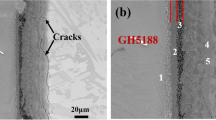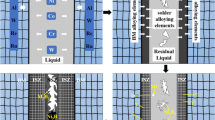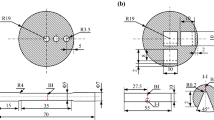Abstract
Vacuum brazing of GH3039 nickel-based alloy with Ni–P filler metal was conducted at different brazing temperature. The Ni–P filler metal with a thickness of 10.4 μm was prepared by electroless plating technique, and the lap joints of GH3039 alloy were obtained. The microstructures and phase compositions of GH3039/Ni–P/GH3039 joints under different brazing temperature were characterized by optical microscopy (OM), scanning electron microscopy (SEM), and X-ray diffraction (XRD). The shear strengths of brazed joints were evaluated by tensile testing machine. According to the different microstructural features, GH3039/Ni–P/GH3039 joint was separated into two regions: solid solution region (region I: Niss) adjacent to base metal (BM) and brittle microstructure (region II: Ni3P + Niss/Ni3P eutectic) in the middle zone. With the increase of brazing temperature, the width of region I (solid solution zone) increased but the thickness of region II (brittle microstructure zone) decreased gradually. The formation of a thinner brittle eutectic zone improved the mechanical properties of GH3039/Ni–P/GH3039 joint. As a result, the maximum shear strength of GH3039/Ni–P/GH3039 joint brazed at 1150 °C could reach 174 MPa. Correspondingly, the fracture mode of GH3039/Ni–P/GH3039 joint changed from cleavage fracture to quasi-cleavage fracture with the increased brazing temperature.










Similar content being viewed by others
References
Wang Z (2019) Recent advances in novel metallic honeycomb structure. Compos Part B-Eng 166:731–741
Mahmoudabadi MZ, Sadighi M (2011) A theoretical and experimental study on metal hexagonal honeycomb crushing under quasi-static and low velocity impact loading. Mater Sci Eng A 528(15):4958–4966
Yasui Y (2000) Dynamic axial crushing of multi-layer honeycomb panels and impact tensile behavior of the component members. Int J Impact Eng 24(6):659–671
Hong S, Pan J, Tyan T, Prasad P (2006) Quasi-static crush behavior of aluminum honeycomb specimens under compression dominant combined loads. Int J Plast 22:73–109
Dharmasena KP, Wadley HNG, Xue Z, Hutchinso JW (2008) Mechanical response of metallic honeycomb sandwich panel structures to high-intensity dynamic loading. Int J Impact Eng 35:1063–1074
Queheillalt DT, Wadley HNG (2009) Titanium alloy lattice truss structures. Mater Des 30:1966–1975
Shahdin A, Mezeix L, Bouvet C, Morlier J, Gourinat Y (2009) Fabrication and mechanical testing of glass fiber entangled sandwich beams: a comparison with honeycomb and foam sandwich beams. Compos Struct 90:404–412
Garam K, Ronald S, Waterloo T (2018) Investigating the effects of fluid intrusion on Nomex honeycomb sandwich structures with carbon fiber facesheets. Compos Struct 206:535–549
Shi YY, Zhao C, Qi M, Liu YB, Deng PF (2013) Research on the cutting force of nickel-based superalloy. Intell Syst Des Eng Appl 4:527–530
Higgins A (2000) Adhesive bonding of aircraft structures. Int J Adhes Adhes 20(5):367–376
Cohal V (2017) Spot Welding of honeycomb structures. IOP Conf Ser: Mater Sci Eng 227(1):012029
Huang X, Richards NL (2004) Activated diffusion brazing technology for manufacture of titanium honeycomb structures-a statistical study. Weld J 83(3):73
Kyzy SU, Völkl R, Munz O, Fischer T, Glatzel U (2019) The effect of brazing on microstructure of honeycomb liner material Hastelloy X. J Mater Eng Perform 28(4):1909–1913
Minamida K, Oikawa M, Sugihashi A, Kido M (1992) Laser welding of metal honeycomb panel with multiple reflecting effects of high power laser beams. J Laser Appl 1:557–564
Han K, Wang H, Shen L, Zhang B (2018) Analysis of cracks in the electron beam welded joint of K465 nickel-base superalloy. Vacuum 157:21–30
Dong H, Yang J, Xia Y, Xu X, Li P, Dong C, Chen J, Liu N, Zheng L (2021) Effect of Cr content in Ni-based amorphous filler on microstructure and shear strength of K4169 nickel-based alloy brazed joint. J Mater Process Tech 290:116975
Ren H, Ren X, Long W, Chen B, Pang S, Xiong H (2021) Formation mechanism of interfacial microstructures and mechanical properties of Ti2AlNb/Ni-based superalloy joints brazed with NiCrFeSiB filler metal. Prog Nat Sci Mater Int 31:310–318
Liu D, Song Y, Shi B, Zhang Q, Song X, Niu H, Feng J (2018) Vacuum brazing of GH99 superalloy using graphene reinforced BNi-2 composite filler. J Mater Sci Technol 34:1843–1850
Doroudi A, Dastgheib A, Omidvar H (2020) The bonding temperature effect of the diffusion brazing Inconel 625 superalloy on the microstructure changes, corrosion resistance, and mechanical properties. J Manuf Process 53:213–222
Liu S, Shohji I, Iioka M, Hashimoto A, Hirohashi J, Wake T, Arai S (2019) Micro-brazing of stainless steel using Ni-P Alloy plating. Appl Sci 9(6):1094
Zou G, Wu A, Zhang D, Meng F, Bai H, Zhang Y, Li Y, Wu S, Gu Z (2004) Joint strength with soldering of Al 2 O 3 ceramics after ni-p chemical plating. Tsinghua Sci Technol 9(5):607–611
Wang P, Xu D, Niu J (2016) Vacuum brazing of electroless Ni–P alloy-coated SiCp/Al composites using aluminum-based filler metal foil. Appl Phys A 122:1069
Sudagar J, Lian J, Sha W (2013) Electroless nickel, alloy, composite and nano coatings – a critical review. J Alloys Compd 571:183–204
Dhakal DR, Gyawali G, Kshetri YK, Choi JH, Lee SW (2020) Microstructural and electrochemical corrosion properties of electroless Ni-P-TaC composite coating. Surf Coat Tech 381:125135
Okamoto H (2010) Ni-P (nickel-phosphorus). J Phase Equilib Diff 31:200–201
Schmetterer C, Vizdal J, Ipser H (2009) A new investigation of the system Ni–P. Intermetallics 17(10):826–834
Martyak NM, Drake K (2000) Peak-profile analysis of electroless nickel coatings. J Alloys Compd 312:30–40
Miller C, Field R, Kaufman M (2018) Phase stability of γ′-Ni2Cr and α-Cr in the Ni-Cr binary. Acta Mater 157:1–10
Duncan RN (1996) The metallurgical structure of electroless nickel deposits: effect on coating properties. Plat Surf Finish 83:65–69
Zorc B, Kosec L (2000) Comparison of brazed joints made with BNi-1 and BNi-7 nickel-base brazing alloys. Rev Metal Madrid 36:100–107
Yeh MS, Chuang TH (1997) Transient liquid phase metallic bonding of an Inconel 71 8SPF superalloy. Weld J 76(12):517s–521s
Zhao W, Lin P, Lin T, He P, Long W, Tian R (2020) Low temperature joining of GH3039 for high temperature applications with Au-Si isothermal solidification. Mater Lett 281:128668
Czagány M, Baumli P, Kaptay G (2017) The influence of the phosphorous content and heat treatment on the nano-micro-structure, thickness and micro-hardness of electroless Ni-P coatings on steel. Appl Surf Sci 423:160–169
Jalilian F, Jahazi M, Drew RAL (2013) Microstructure evolution during transient liquid phase bonding of alloy 617. Metallogr Microstruct Anal 2:170–182
Funding
This work was supported by the Key Technology Research and Development Program of Shandong [grant number: 2019JZZY010439] and Opening Funding of State Key Laboratory of Advanced Welding and Joining, China [grant number: AWJ-22M19].
Author information
Authors and Affiliations
Corresponding authors
Ethics declarations
Conflict of interest
The authors declare no competing interests.
Additional information
Publisher's note
Springer Nature remains neutral with regard to jurisdictional claims in published maps and institutional affiliations.
Recommended for publication by Commission XVII—Brazing, Soldering and Diffusion Bonding
Rights and permissions
About this article
Cite this article
Lv, Y., Han, K. & Wang, T. Effect of brazing temperature on the interfacial microstructure and mechanical properties of GH3039 joint brazed with electroless Ni–P filler metal. Weld World 65, 2221–2229 (2021). https://doi.org/10.1007/s40194-021-01174-4
Received:
Accepted:
Published:
Issue Date:
DOI: https://doi.org/10.1007/s40194-021-01174-4




